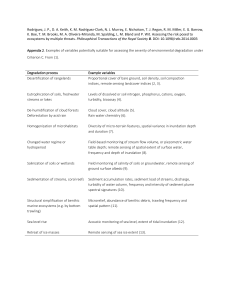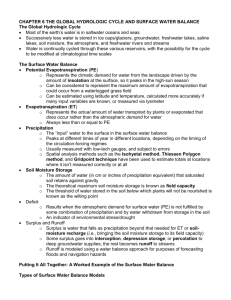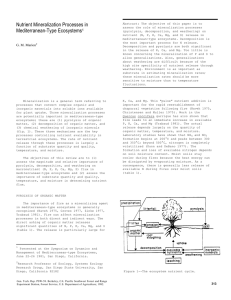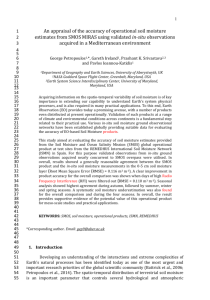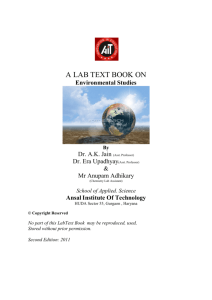AP Environmental Syllabus
advertisement
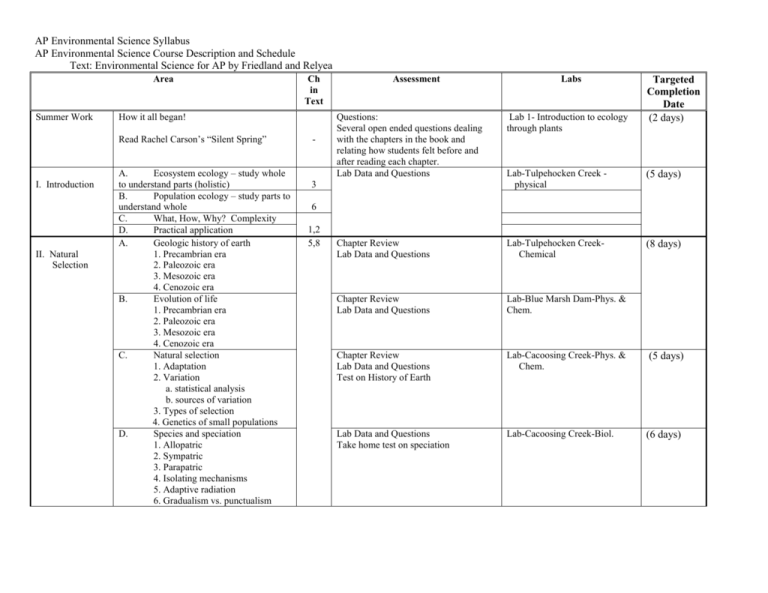
AP Environmental Science Syllabus AP Environmental Science Course Description and Schedule Text: Environmental Science for AP by Friedland and Relyea Area Summer Work How it all began! Read Rachel Carson’s “Silent Spring” I. Introduction II. Natural Selection Ch in Text A. Ecosystem ecology – study whole to understand parts (holistic) B. Population ecology – study parts to understand whole C. What, How, Why? Complexity D. Practical application A. Geologic history of earth 1. Precambrian era 2. Paleozoic era 3. Mesozoic era 4. Cenozoic era B. Evolution of life 1. Precambrian era 2. Paleozoic era 3. Mesozoic era 4. Cenozoic era C. Natural selection 1. Adaptation 2. Variation a. statistical analysis b. sources of variation 3. Types of selection 4. Genetics of small populations D. Species and speciation 1. Allopatric 2. Sympatric 3. Parapatric 4. Isolating mechanisms 5. Adaptive radiation 6. Gradualism vs. punctualism - Assessment Labs Targeted Completion Date (2 days) Questions: Several open ended questions dealing with the chapters in the book and relating how students felt before and after reading each chapter. Lab Data and Questions Lab 1- Introduction to ecology through plants Lab-Tulpehocken Creek physical (5 days) Chapter Review Lab Data and Questions Lab-Tulpehocken CreekChemical (8 days) Chapter Review Lab Data and Questions Lab-Blue Marsh Dam-Phys. & Chem. Chapter Review Lab Data and Questions Test on History of Earth Lab-Cacoosing Creek-Phys. & Chem. (5 days) Lab Data and Questions Take home test on speciation Lab-Cacoosing Creek-Biol. (6 days) 3 6 1,2 5,8 III. Conditions for Life A. Homeostasis B. Sun C. Climate 1. Atmospheric movement 2. Relative humidity 3. Ocean currents 4. El Nino Microclimates Climate modification D. E. 4 Chapter Review Lab Data and Questions Lab Data and Questions Lab Data and Questions Comparative write-up on status of Cacoosing vs Tulpehocken Creeks Test on air and water flow on Earth Lab-Tulpehocken Creek-Biol Lab- Cacoosing Creek-Fish Shocking Lab-Hawk Mtn.-raptor migration (15 days) V. Temperature A. Movement of heat B. D. A. Thermoregulation in animals 1. Poikilothermy 2. Homeothermy 3. Body size Heat strategies 1. Behavioral 2. Morphological 3. Physiological a. continuously active b. periodically inactive Plant adaptations to temperature Physical properties of water B. C. D. E. A. B. Plant response to moisture Animal response to moisture Salinity Temperature moisture interaction Nature of light Shade tolerance C. D. Light in water Photosynthesis 1. C3 cycle 2. C4 cycle 3. C.A.M. cycle Periodicity 1. Biological clocks 2. Daily 3. Annual 4. Other Energy and thermodynamics C. V. Moisture VI. Light E. VII. Production in Ecosystems A. B. C. VIII. Trophic structure 3,6 Chapter Review Lab Data and Questions 9 Food webs 1. Components 2. Major food “chains” B. Nutrient flow Lab-Population Studies-Middle Creek Lab-Deciduous Forest-Penn State Chapter Review Lab Data and Questions Test on Thermoregulation Lab-Coniferous Forest-Penn State Chapter Review Lab Data and Questions Lab- succession- Lake Ontelaunee Lab-Population sampling techniques Lab Data and Questions 3 Primary productivity 1. GPP vs. NPP 2. Shoot to root 3. Vertical distribution Secondary productivity A. Lab Data and Questions 3 (15 days) (12 days) (11 days) Lab Data and Questions Lab-Snow Goose Ecology and Population sampling Ontelaunee Lab Data and Questions Lab paper on comparison of Jamaica waters to New York waters Lab-Tropical Ecology- St. Ann’s Bay, Jamaica Chapter Review Lab Data and Questions Test on Light Lab-Population density and biomass Lab Data and Questions (13 days) Lab Data and Questions Lab-Avian Ecology and Identification-3 labs Lab-NPP-Blue Marsh Chapter Review Test on Productivity Lab Data and Questions Lab-Microclimates-Blue Marsh (7 days) Chapter Review IX. Soil A. B. C. X. Ecosystems(soil, climate, vegetation, animal life, human impact) Soil development 1. Physical weathering 2. Biological weathering 3. Chemical weathering 4. Soil horizons Soil profiles D. E. A. Soil characteristics 1. Chemistry 2. Texture 3. Moisture Soil as an environment Erosion Grasslands B. C. D. E. F. Savanna Shrubland Desert Tundra Taiga G. Temperate forests 1. Coniferous 2. Broadleaf Tropical forests 1. Rainforest 2. Seasonal 3. Dry Ponds and lakes Wetlands 1. Marshes 2. Swamps 3. Bogs Flowing water ecosystems Estuaries Open ocean 1. Benthos 2. Pelagic Coral reef Intertidal 1. Rocky 2. Sandy or muddy H. I. J. K. L. M. N. O. 8 Lab Data and Questions Lab-Deciduous and Coniferous Soil-Penn State Berks Lab Data and Questions Lab-Agricultural Soil-Hartman’s farm (12 days) Chapter Review Lab paper on comparison of soils in different forests vs agricultural fields. Chapter Review Lab Data and Questions Lab-Bogs-Hawk Mountain Lab Data and Questions Lab-Man made ecosystemsMiddle Creek 4 4 13 Test on Ecosystems (11 days) A. Overpopulation XI. Environmental Issues 7 Test on Human demographics 18 Chapter Review Lab Data and Questions Lab-Spring Twp. Sewage Treatment Plant C. Global Warming and Ozone DepletionCauses and solutions 15,19 Chapter Review Lab Data and Questions Lab-Western Berks Water Treatment Plant D. Renewable Energy-Alternative sources of energy 12 Chapter Review E. Air Pollution-Outdoor and indoor air pollution 14 Chapter Review Lab Data and Questions Lab-Air Pollution tests F. Toxic and Solid Waste-Disposal, regulations, prevention 16 Chapter Review Lab Data and Questions Lab-Pioneer Sanitary Landfill G. Pesticides-History, problems, and alternatives 18 Chapter Review Lab Data and Questions Test on Air, water, and land pollution Lab-Mid Atlantic Coastal Marine Ecology-Wallops Island Marine Science Consortium H. Land and Water ManagementConservation, problems, and wilderness 10 Chapter Review I. Preserving Animal Diversity-Human encroachment and sustainable management 17 Chapter Review Test on Land Use J. Economics, Politics, Ethics and the Environment-Dealing with environmental policy, problem solving, and environmental education 11, 20 Chapter Review B. Loss of BiodiversityEndangered plants and animals AP Final Review AP Final for AP Exam Post Test Activities (29 days) (2 days) (5 days) (12 days)

